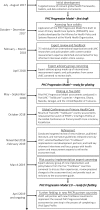PHC Progression Model: a novel mixed-methods tool for measuring primary health care system capacity
- PMID: 31565420
- PMCID: PMC6748065
- DOI: 10.1136/bmjgh-2019-001822
PHC Progression Model: a novel mixed-methods tool for measuring primary health care system capacity
Abstract
High-performing primary health care (PHC) is essential for achieving universal health coverage. However, in many countries, PHC is weak and unable to deliver on its potential. Improvement is often limited by a lack of actionable data to inform policies and set priorities. To address this gap, the Primary Health Care Performance Initiative (PHCPI) was formed to strengthen measurement of PHC in low-income and middle-income countries in order to accelerate improvement. PHCPI's Vital Signs Profile was designed to provide a comprehensive snapshot of the performance of a country's PHC system, yet quantitative information about PHC systems' capacity to deliver high-quality, effective care was limited by the scarcity of existing data sources and metrics. To systematically measure the capacity of PHC systems, PHCPI developed the PHC Progression Model, a rubric-based mixed-methods assessment tool. The PHC Progression Model is completed through a participatory process by in-country teams and subsequently reviewed by PHCPI to validate results and ensure consistency across countries. In 2018, PHCPI partnered with five countries to pilot the tool and found that it was feasible to implement with fidelity, produced valid results, and was highly acceptable and useful to stakeholders. Pilot results showed that both the participatory assessment process and resulting findings yielded novel and actionable insights into PHC strengths and weaknesses. Based on these positive early results, PHCPI will support expansion of the PHC Progression Model to additional countries to systematically and comprehensively measure PHC system capacity in order to identify and prioritise targeted improvement efforts.
Keywords: Primary care; capacity; global health; measurement; primary health care; universal health coverage.
© Author(s) (or their employer(s)) 2019. Re-use permitted under CC BY. Published by BMJ.
Conflict of interest statement
Competing interests: None declared.
Figures



References
-
- World Health Organization, United Nations Children’s Fund . Declaration of Astana. World Health Organization and United Nations Children’s Fund, 2018.
-
- Das J, Hammer J. Quality of primary care in low-income countries: facts and economics. Annu Rev Econom 2014;6:525–53. 10.1146/annurev-economics-080213-041350 - DOI
-
- Kruk M, Gage A, Arsenault C, et al. . High quality health systems—time for a revolution: report of the Lancet global health Commission on high quality health systems in the SDG era. Lancet Global Health.
-
- Primary Health Care Performance Initiative. Available: http://www.improvingphc.org [Accessed 14 Dec 2018].
Publication types
LinkOut - more resources
Full Text Sources
Miscellaneous
